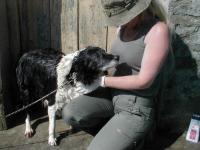0














| Thumbs Up |
| Received: 39 Given: 0 |

source, Scotsman online.
Phones fingered in spread of superbugs
Published Date: 04 January 2009
By Kate Foster
FIRST it was handwashing, then it was cleaning the floors. Now mobile phones are revealed to be the latest battleground for hospital superbugs as a team of experts reveals the bacteria thrive on handsets.
A startling image released by researchers reveals colonies of bacteria grown from a working hospital doctor's mobile phone.
The photograph has been issued by a group of infection specialists investigating the spread of hospital superbugs, such as Clostridium difficile (C diff) and MRSA, between staff and patients.
They say the image reveals the ease with which deadly bacteria can be unwittingly carried around hospitals by members of staff.
The research has been carried out by Richard Brady, a surgical research fellow at the Western General Hospital, Edinburgh.
Brady said his study was prompted by the rise in the use of mobile phones by hospital staff and the lack of guidance on how to clean them, despite strict handwashing policies.
There are concerns that the mobile phones could be a route of transmitting infections because they are in regular contact with users' hands and close to their mouths, and because, despite regular handwashing, the bacteria on them could survive if they are not wiped clean.
A ban on mobile phones in hospitals has been relaxed in recent years
and doctors have begun to rely on them, rather than the traditional hospital switchboard paging system, for instant communications with colleagues.
Brady said: "Mobile phones are being used in all aspects of healthcare delivery. They are the much preferred route because it makes communication more efficient. However, one aspect that has not been covered is bacterial contamination. They are particularly susceptible to this because they are in close contact with the mouth and hands, and travel to various clinical environments."
The researchers are part of the Scottish Infection Research Network and have been working with a group of scientists at Manchester Metropolitan University
Brady said researchers took the mobile phone from a hospital doctor and placed it on agar, a gel used as a growth medium, to get an imprint. The gel was then placed in an incubator overnight to allow any individual bacteria on the phone to grow into colonies. The coloured spots in the image are the different colonies of bacteria.
Brady added: "The vast majority of bacteria here will be normally found on the skin and do not cause hospital-acquired infections; however, there may be a few that do."
Brady's team have published studies that show a potential for mobile phones to act as reservoirs for bacteria. He added: "
But at the moment there are no obvious guidelines to staff regulating the use of mobile phones in relation to bacterial contamination or how to clean them. There need to be increased levels of education of healthcare staff to help them realise there may be issues."
Last year there were 6,430 C diff cases in Scottish hospitals and care homes, of which 597 were fatal. Hospitals have been told to cut C diff cases by 30% over the next three years. Deaths linked to MRSA reached record levels in Scotland last year, and the infection was a factor in 230 deaths during 2007.
The research was welcomed last night by patients' groups. Margaret Watt, chairwoman of the Scotland Patients Association, said:
"Hospital-acquired infections are not straightforward and not just about dirty beds. It's everything. There are a multitude of things that have not even been looked at yet."
A Scottish Government spokeswoman said: "It is good hand hygiene which is key in reducing the risk of healthcare-associated infections."
There are currently 1 users browsing this thread. (0 members and 1 guests)
Bookmarks